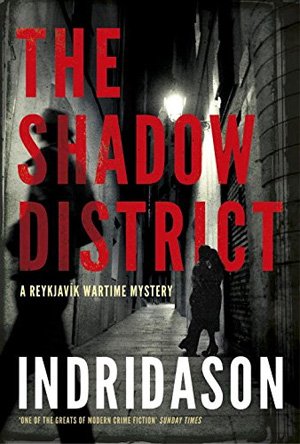
The area known as the Shadow District is a mixture of industrial, commercial, and residential properties in Reykjavik. During World War II, when the country was occupied first by the British and then by American troops, it became a popular place for young Icelandic women to meet their foreign lovers – a practice which was unpopular with a large part of society, and referred to tactfully as ‘the Situation’.
Ingiborg is one young lady caught up in the Situation. Her stern father’s disapproval means she must meet her American sweetheart, Frank Carroll, in secret and as the book begins they have chosen to have their liaison behind the National Theatre. Any romantic thoughts are ruined by the discovery of a young female corpse, clad only in a thin nightdress. Ingiborg allows Frank to dissuade her from calling the police, and the couple believe they have escaped unseen, avoiding any scandal that would result if their relationship were exposed.
Unfortunately that is not to be the case, and the following morning the police knock on her door. Flovent is one of the few Icelandic detectives not given other duties during the War and his accomplice is Thorson, a Canadian with Icelandic roots who acts as a liaison for the American military police. Though the two men are dedicated and competent investigators, and ultimately a man is arrested for her murder – and is the only suspect in another girl’s murder three years earlier – the mystery of who killed Rosamunda later will never be solved completely to their satisfaction during their careers.
Fast forward to the present day, and Konrad, a retired detective is persuaded to unofficially assist the Reykjavik police with another murder. Stefan Thordarson was 90 and thought initially to have died peacefully in his sleep of natural causes, but a routine autopsy reveals he was smothered by a pillow. In his flat are a number of newspaper cuttings which refer to Rosamunda’s death, and these prompt feelings of anxiety in Konrad, who has a secret family connection to the case, and which is a source of shame to him. As Konrad begins working the Thordarson case, he begins to realise that the old man may have been trying to find out what happened to Rosamunda. But why would this be so, and what breakthrough might he have made?
The narrative switches between the two investigations, and I think a lesser writer may have allowed things to get a little confusing. Thankfully, Indridason’s considered, precise prose not only keeps the details of the separate timelines clear for us, but conveys with a minimum of embellishment the motivation of the characters and the themes of the story. Indridason and Henning Mankell both wrote excellent police procedural series that at their heart have antagonistic, and reticent male protagonists, and whilst Mankell wrote his prose with more stylistic flourish, it is Indridason’s clear and precise approach that makes him, I believe, the better writer.
The Shadow District is by no means a long novel, yet within its covers can be found not one mystery but two, as well as a carefully evoked historical setting and a story that ask questions of family responsibility, purpose in later life, and how society changes over time. I think that is a pretty good deal for readers and The Shadow District is well worth reading.
Take a look at our Detective Erlendur primer, as well as guide to Henning Mankell’s popular Wallander.
Harvill Secker
Print/Kindle
£9.09
CFL Rating: 5 Stars